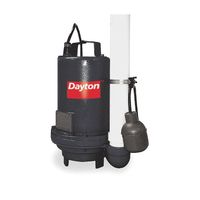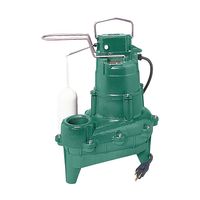Call +(254) 703 030 000 / 751 483 999 / 721 704 777
- Home
- Pumps
- Sump Sewage Utility Pumps
- Sewage Effluent Pumps
Sewage & Effluent Pumps
Sewage pumps and effluent pumps are used to transfer sewage (wastewater containing solids) and gray water (household wastewater from a sink or bath) into a septic or sewage system. Sewage ejector pumps allow sewage to be pumped from drains that are below the main sewer line to either septic systems .....Read More
Frequently Asked Questions
What is the difference between a sewage pump and an effluent pump?
A sewage pump and an effluent pump are both used in wastewater management, but they serve different purposes and handle different types of waste.
A sewage pump is designed to move both liquids and solids from one place to another. It is typically used in residential, commercial, or industrial settings to transport raw sewage from a home or building to a septic tank or a municipal sewer system. Sewage pumps are capable of handling solids up to 2 inches in diameter, making them suitable for moving raw sewage that contains human waste, toilet paper, and other debris. They are often submersible and are installed in a sewage basin or pit.
An effluent pump, on the other hand, is used to move wastewater that is mostly liquid with minimal solid content. It is commonly used in septic systems to pump the clarified effluent from a septic tank to a drain field or leach field. Effluent pumps are designed to handle smaller solids, typically up to 3/4 inch in diameter, as the effluent has already undergone primary treatment in the septic tank, where most solids have settled out. These pumps are also submersible and are installed in a separate chamber or compartment of the septic tank.
In summary, the main difference lies in the type of waste they handle: sewage pumps are for raw sewage with larger solids, while effluent pumps are for treated wastewater with smaller solids.
How do I choose the right sewage pump for my home?
To choose the right sewage pump for your home, consider the following factors:
1. **Type of Pump**: Determine whether you need an effluent pump, a sewage ejector pump, or a grinder pump. Effluent pumps handle gray water, sewage ejector pumps handle solid waste, and grinder pumps are used for high-head applications or when waste needs to be broken down.
2. **Capacity and Flow Rate**: Calculate the required flow rate in gallons per minute (GPM) based on the number of fixtures and the household size. Ensure the pump can handle peak usage.
3. **Head Pressure**: Measure the vertical distance from the pump to the discharge point. Choose a pump that can handle the total dynamic head (TDH), which includes vertical lift and friction loss in pipes.
4. **Power Source**: Ensure the pump's voltage and phase match your home's electrical system. Most residential pumps use 115V or 230V.
5. **Material and Durability**: Select a pump made from durable materials like cast iron or stainless steel for longevity and resistance to corrosion.
6. **Switch Type**: Choose between tethered, vertical, or electronic switches. Tethered switches are suitable for larger basins, while vertical switches fit smaller spaces. Electronic switches offer precision and reliability.
7. **Installation and Maintenance**: Consider ease of installation and access for maintenance. Some pumps come with quick-connect systems or require professional installation.
8. **Noise Level**: If noise is a concern, look for pumps with noise-reduction features or install them in soundproofed areas.
9. **Brand and Warranty**: Opt for reputable brands with good customer reviews and a solid warranty for peace of mind.
10. **Budget**: Balance cost with features and reliability. Investing in a quality pump can save money on repairs and replacements in the long run.
What maintenance is required for sewage and effluent pumps?
Regular maintenance of sewage and effluent pumps is crucial to ensure their efficient operation and longevity. Key maintenance tasks include:
1. **Inspection**: Regularly inspect the pump for any visible signs of wear, damage, or corrosion. Check the power cord for any fraying or damage.
2. **Cleaning**: Clean the pump and its components to prevent clogging. Remove any debris or buildup from the pump housing, impeller, and float switch.
3. **Testing**: Periodically test the pump to ensure it is functioning correctly. This includes checking the float switch operation and ensuring the pump activates and deactivates as expected.
4. **Lubrication**: Lubricate moving parts as recommended by the manufacturer to reduce friction and wear.
5. **Seal Check**: Inspect and replace seals if necessary to prevent leaks and ensure the pump remains watertight.
6. **Electrical Connections**: Check all electrical connections for tightness and corrosion. Ensure the pump is properly grounded.
7. **Discharge Line**: Inspect the discharge line for any blockages or leaks. Ensure it is securely connected and free of obstructions.
8. **Alarm System**: If equipped, test the alarm system to ensure it alerts you in case of pump failure or high water levels.
9. **Backup System**: If a backup pump or power source is available, test it regularly to ensure it is operational in case of primary pump failure.
10. **Professional Servicing**: Schedule regular professional servicing to address any complex issues and ensure the pump is in optimal condition.
By adhering to these maintenance practices, you can prevent pump failures, reduce repair costs, and extend the lifespan of your sewage and effluent pumps.
How long do sewage and effluent pumps typically last?
Sewage and effluent pumps typically last between 5 to 15 years, depending on several factors such as the quality of the pump, frequency of use, maintenance practices, and the specific conditions in which they operate. High-quality pumps made from durable materials like cast iron or stainless steel tend to have a longer lifespan. Regular maintenance, including cleaning, inspection, and timely replacement of worn-out parts, can significantly extend the life of these pumps.
The frequency and nature of use also play a crucial role. Pumps that operate continuously or handle large volumes of waste may experience more wear and tear, leading to a shorter lifespan. Conversely, pumps used less frequently or for lighter loads may last longer. Environmental conditions, such as the presence of corrosive substances or extreme temperatures, can also impact the longevity of sewage and effluent pumps.
Proper installation is another critical factor. Pumps that are correctly installed and aligned are less likely to experience mechanical failures. Additionally, using the pump within its specified capacity and avoiding overloading can prevent premature wear.
In summary, while the typical lifespan of sewage and effluent pumps ranges from 5 to 15 years, this can vary widely based on quality, usage, maintenance, and environmental conditions. Regular maintenance and proper usage are key to maximizing the operational life of these pumps.
Can sewage pumps handle solids and debris?
Sewage pumps are specifically designed to handle solids and debris, but their capacity to do so depends on the type and design of the pump. There are two main types of sewage pumps: grinder pumps and solids-handling pumps.
Grinder pumps are equipped with cutting blades that grind solid waste into smaller particles before pumping it through the system. This makes them suitable for applications where the sewage needs to be transported over long distances or uphill, as the smaller particles are less likely to cause blockages. Grinder pumps are typically used in residential or small commercial settings where the sewage system is connected to a municipal sewer line.
Solids-handling pumps, on the other hand, are designed to move larger solids without the need for grinding. These pumps have larger impellers and wider passages, allowing them to pass solids up to a certain size, typically ranging from 2 to 4 inches in diameter. They are commonly used in municipal and industrial applications where the volume of sewage and the size of the solids are larger.
Both types of pumps are effective in handling solids and debris, but their efficiency can be affected by the nature and size of the materials present in the sewage. Non-biodegradable items, such as wipes, sanitary products, and plastics, can still cause blockages and damage to the pumps. Regular maintenance and proper waste disposal practices are essential to ensure the longevity and efficiency of sewage pumps.
In summary, while sewage pumps are capable of handling solids and debris, their effectiveness is contingent upon the pump type and the nature of the materials being processed. Proper selection, installation, and maintenance are crucial to prevent operational issues.
What are common problems with sewage and effluent pumps?
Common problems with sewage and effluent pumps include:
1. **Clogging**: Debris, wipes, and non-biodegradable materials can block the pump impeller or discharge line, reducing efficiency or causing failure.
2. **Pump Overload**: Excessive load due to high volume or density of waste can cause the motor to overheat, leading to potential burnout.
3. **Seal Failure**: Mechanical seals can wear out over time, allowing water to enter the motor housing, which can cause electrical failures.
4. **Corrosion**: Continuous exposure to harsh chemicals and waste can corrode pump components, leading to leaks and reduced lifespan.
5. **Air Lock**: Air trapped in the pump or discharge line can prevent the pump from priming, reducing its ability to move waste effectively.
6. **Float Switch Malfunction**: Float switches can become stuck or fail, preventing the pump from turning on or off at the correct times, leading to overflow or dry running.
7. **Electrical Issues**: Faulty wiring, power surges, or inadequate power supply can cause electrical failures or inconsistent pump operation.
8. **Bearing Wear**: Bearings can wear out due to continuous operation or lack of lubrication, leading to increased noise and eventual pump failure.
9. **Improper Installation**: Incorrect installation can lead to misalignment, vibration, and premature wear of pump components.
10. **Sump Pit Issues**: A sump pit that is too small or improperly designed can lead to frequent cycling, which increases wear and tear on the pump.
11. **Backflow**: Without a proper check valve, waste can flow back into the system, causing repeated cycling and potential overflow.
12. **Vibration and Noise**: Excessive vibration or noise can indicate misalignment, imbalance, or worn components, which can lead to further damage if not addressed.
How do I install a sewage or effluent pump system?
1. **Plan and Design**: Determine the location for the pump system, ensuring it is near the sewage basin and has access to electrical power. Check local codes for compliance.
2. **Excavate and Prepare Basin**: Dig a hole for the sewage basin, ensuring it is deep enough for the basin to sit flush with the ground. Place a layer of gravel at the bottom for drainage.
3. **Install the Basin**: Lower the sewage basin into the hole, ensuring it is level. Backfill around the basin with gravel or soil, compacting it to prevent movement.
4. **Install the Pump**: Place the sewage pump inside the basin. Connect the pump to the discharge pipe, ensuring a tight fit to prevent leaks. Use a check valve on the discharge line to prevent backflow.
5. **Connect the Vent Pipe**: Attach a vent pipe to the basin to allow gases to escape. Ensure it extends above the roofline or as per local codes.
6. **Electrical Connections**: Connect the pump to a dedicated GFCI-protected electrical outlet. Ensure all wiring is done according to local electrical codes.
7. **Test the System**: Fill the basin with water to test the pump. Ensure it activates and discharges water properly. Check for leaks and proper operation of the check valve.
8. **Cover and Secure**: Place the basin cover securely, ensuring it is sealed to prevent odors. Secure the cover with bolts if necessary.
9. **Final Inspection**: Conduct a final inspection to ensure all components are installed correctly and the system operates efficiently. Adjust as needed.
10. **Maintenance**: Regularly inspect and maintain the pump system to ensure longevity and efficiency. Clean the basin and check the pump operation periodically.

